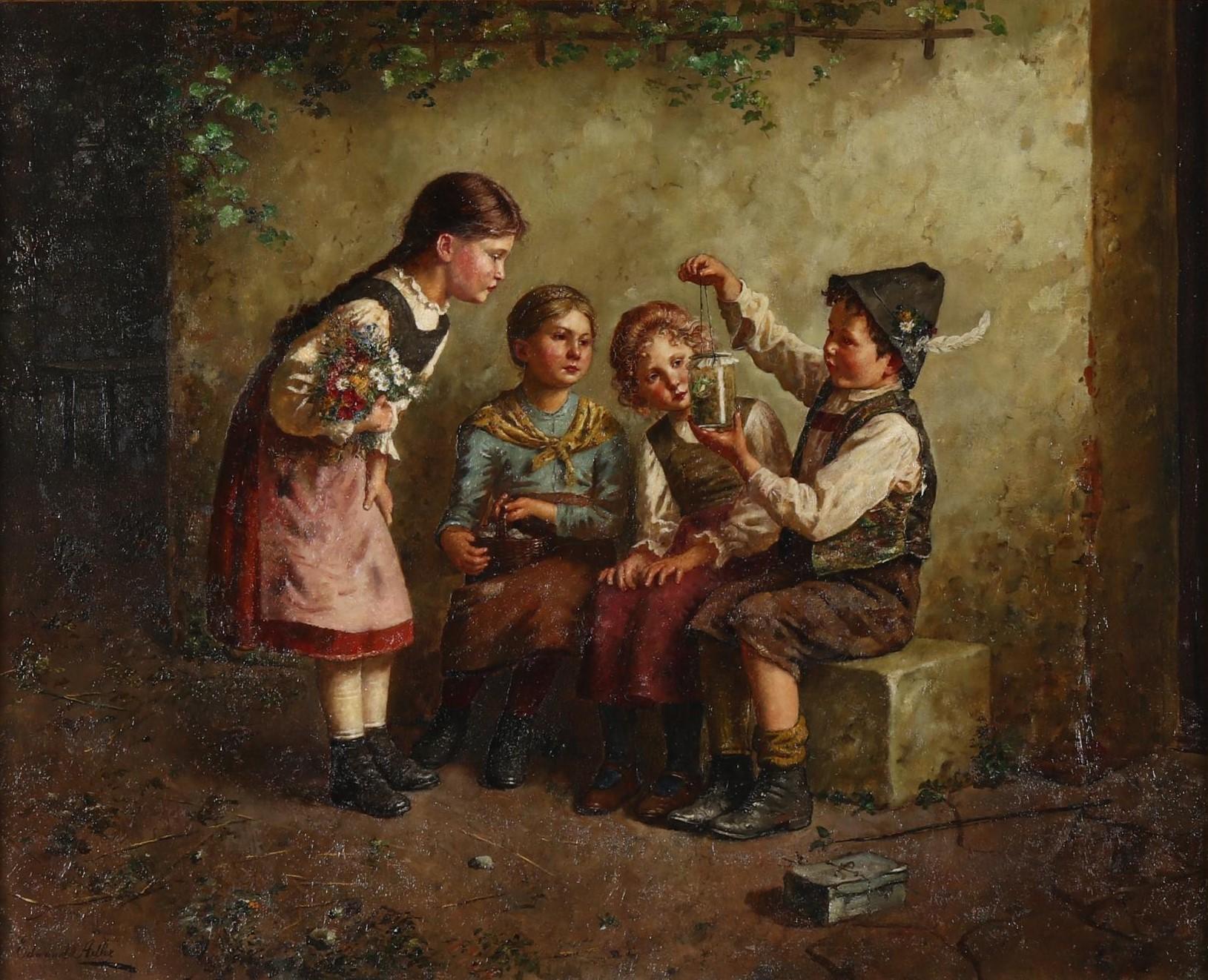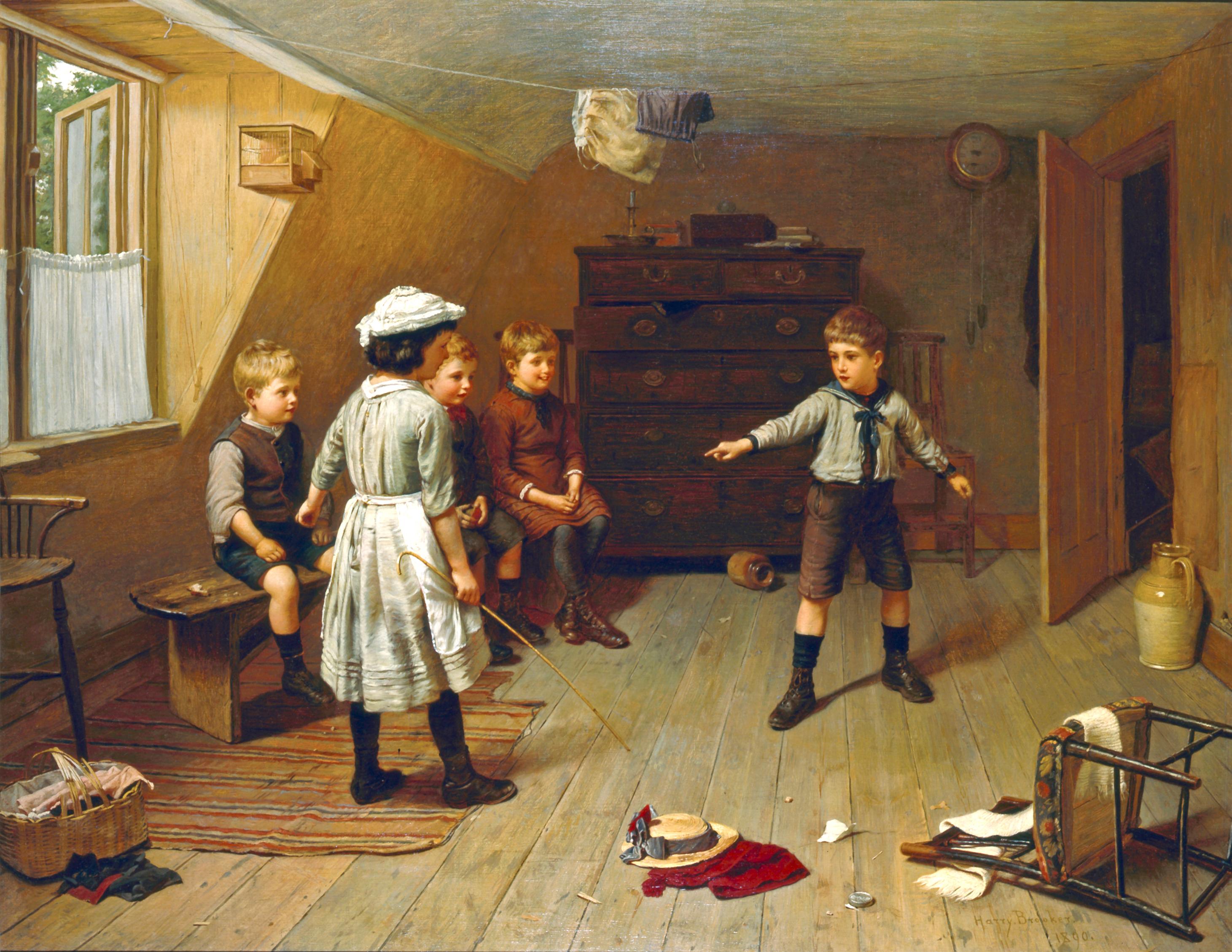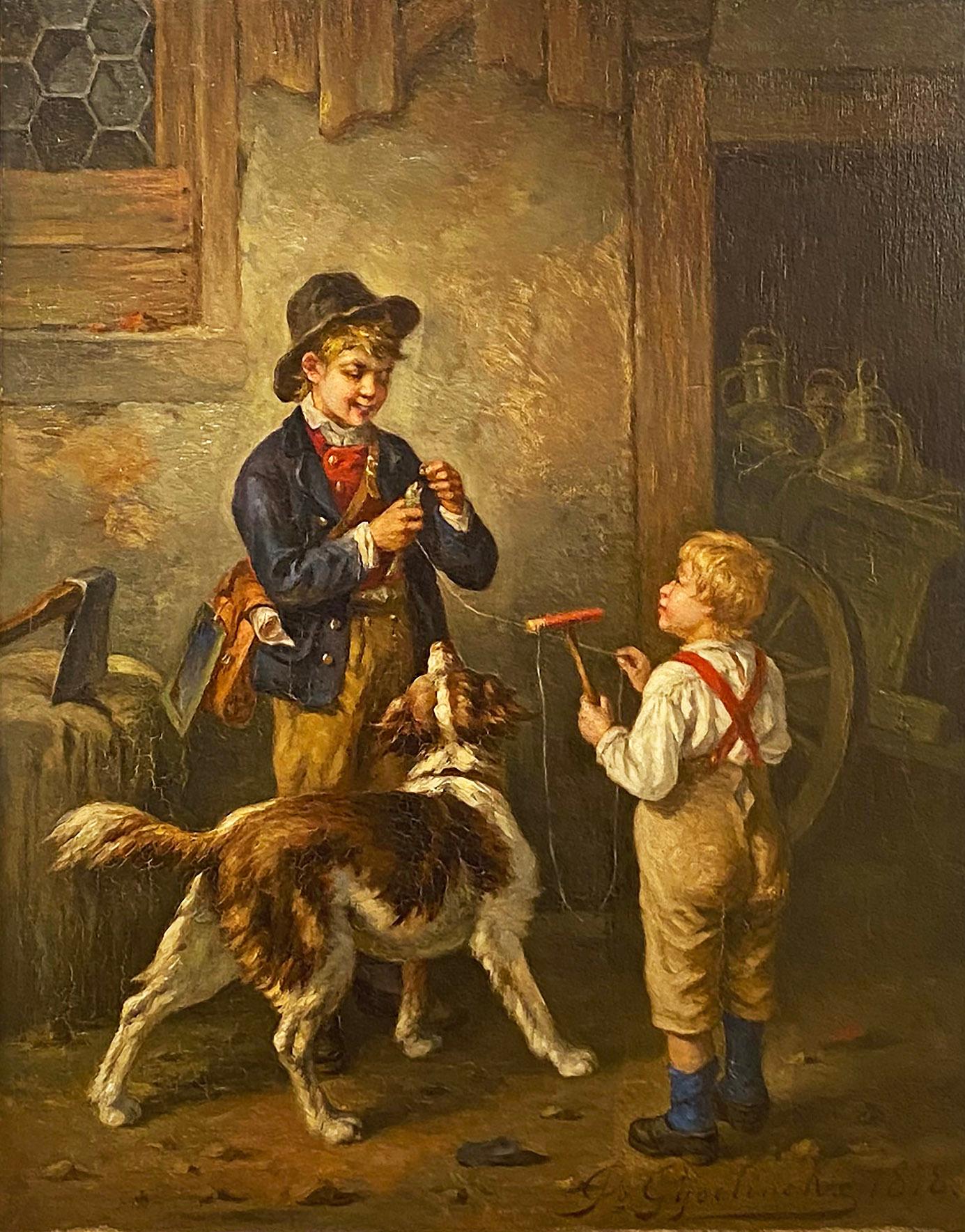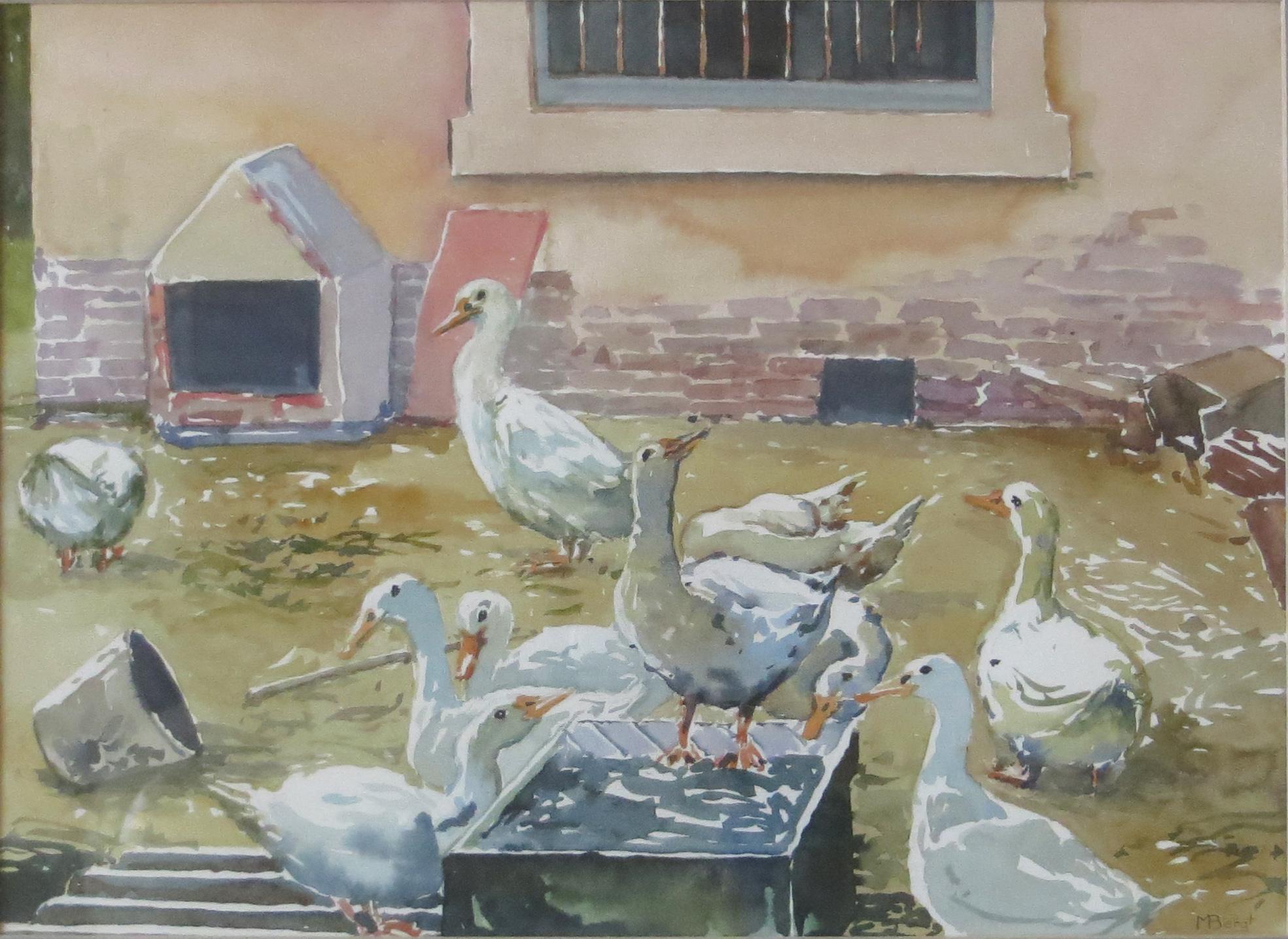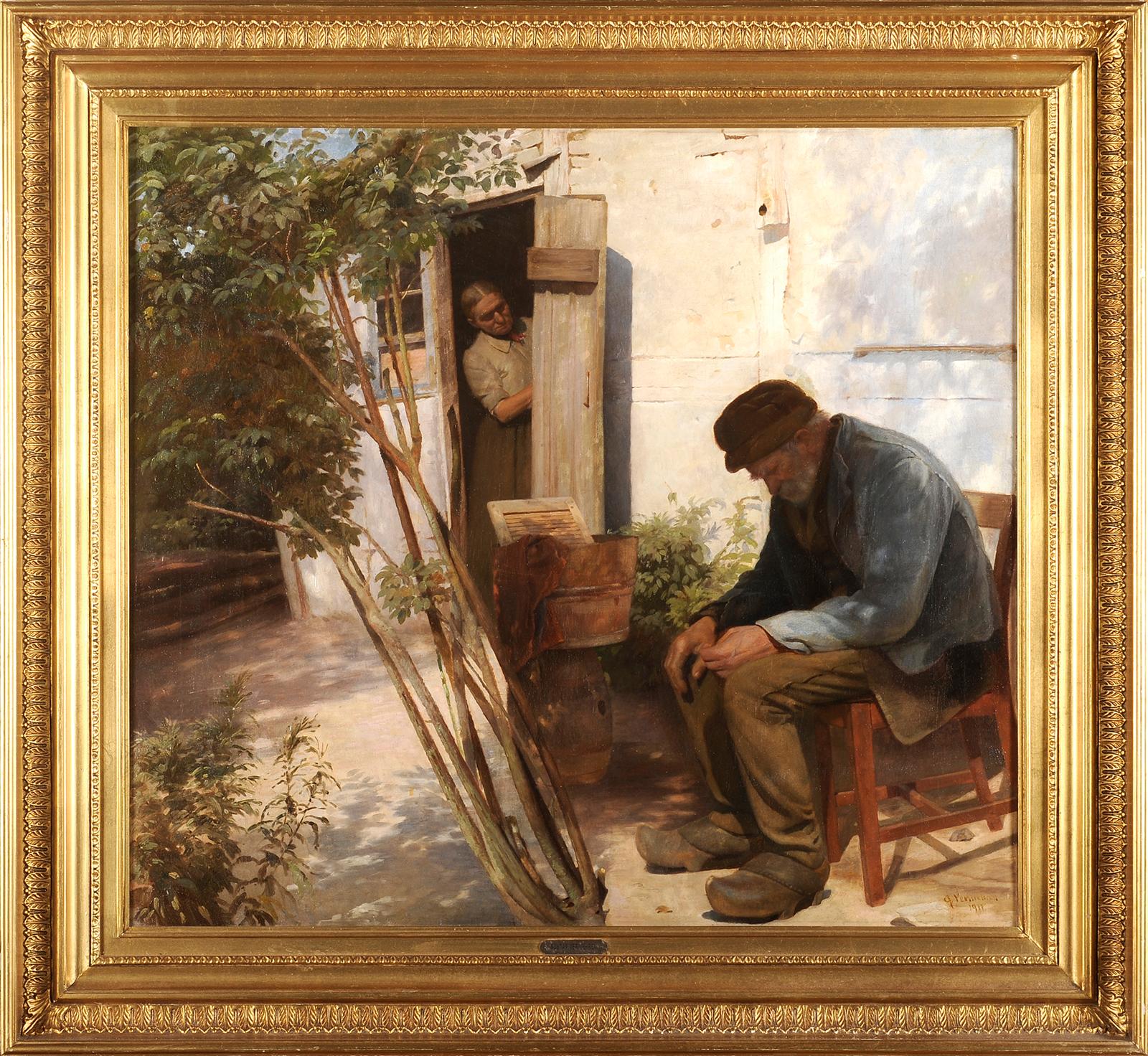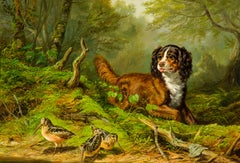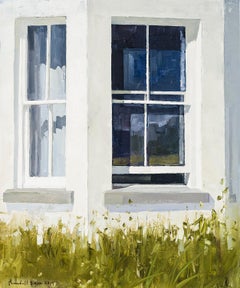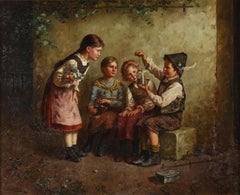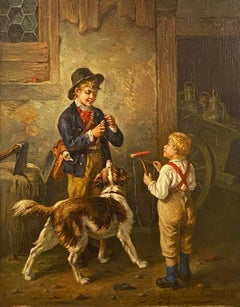Want more images or videos?
Request additional images or videos from the seller
1 of 5
Charles Caleb Ward His Only Pet1871
1871
$20,000
£15,296.49
€17,505.32
CA$28,465.49
A$30,819.83
CHF 16,385.48
MX$371,708.40
NOK 206,056.71
SEK 192,103.54
DKK 130,742.56
About the Item
Charles Caleb Ward was born in St. John, New Brunswick, Canada, the grandson of a New York Ward who had left for New Brunswick around the time of the Revolutionary War because of loyalist sympathies. The Ward family grew to local prominence there, becoming involved in the shipping and quarrying businesses. As a young man, Charles Caleb Ward was sent to London to learn the family shipping business. Instead, he spent most of his time studying art with the English pre-Raphaelite painter, William Henry Hunt (1790–1864), who was known for his meticulous still lifes often centered on a bird’s nest in a forest setting. After living in London and Paris for several years, Ward moved to New York in 1850, and stayed for a year before leaving the city to travel variously throughout the East, and eventually resettled and married in New Brunswick. Ward returned to New York in 1868, where he maintained a studio at least until 1872. His whereabouts for the next ten years are not known, but it seems likely that he may have remained in New York until the early 1880s.
Ward is known to have been back in Canada by 1881, as when one of his works was included in the National Academy of Design’s annual exhibition in that year, he was recorded as living in New Brunswick. But, this does confirm that Ward maintained a tie to the New York art world even after his return to Canada. Very little is known of his activity after 1881, although a small number of works have surfaced from the late 1880s and 1890s. He died in Rothesay, New Brunswick, in 1896.
Ward’s years in New York were his most active as a professional artist. He exhibited often at New York venues, including the National Academy of Design, the American Society of Painters in Water Colors, the Century Association, and the Brooklyn Art Association. He also sent works to the Union League Club, Philadelphia; the Cincinnati Academy, Ohio; the Utica Art Association, New York; and the Louisville Industrial Exposition, Kentucky.
Though our knowledge today of Ward’s activity and oeuvre is fragmentary, he was held in high esteem in his own time. William H. Gerdts has noted that Ward “was among the finest genre specialists of the mid-century, and one whose work has been somewhat neglected, as much because of its rarity as for any other reason” (19th Century American Painting from the Collection of Henry Melville Fuller, exhib. cat. [Manchester, New Hampshire: Currier Gallery of Art, 1971), p. 9). Indeed, Ward specialized in genre scenes, mostly of children and Native Americans, both in oil and watercolor. Ward was especially renowned for his small-format genre paintings, and it was said of his work that “his pictures were small in size, but so finely and beautifully executed that they would always bear close scrutiny with a powerful glass” (David Russell Jack, Acadiensis VI [1906], p. 97). Although Ward was evidently a prolific artist, few works by him are known. Most are in Canadian collections, though a few are in prominent American museum collections, including the National Gallery of Art, Washington, D.C.; The Metropolitan Museum of Art, New York; the Smith College Museum of Art, Northampton, Massachusetts; the Bowdoin College Museum of Art, Brunswick, Maine; the Mead Art Museum, Amherst College, Amherst, Massachusetts; and the Currier Gallery of Art, Manchester, New Hampshire.
Painted in 1871, His Only Pet hails from Ward’s period of activity in New York. It is one of Ward’s typically small, gem-like genre pieces, and as with many of these the artist manages to combine both a humorous and sentimental subject with a variety of masterful details that subtly enrich the composition. Outside a weathered, stuccoed brick barn, three barefoot urchins discover a dead bird on the ground. A calico cat, having killed the bird, watches the scene coolly from a perch high up on a ladder that hangs on the exterior wall of the barn. Two of the boys kneel down to get a closer look at the bird, marveling at its diminutive, upturned form. The third boy, on the other hand, remains standing and wipes a tear from his face with the back of his hand, having lost his only pet that somehow has escaped its cage. Filling out the composition are a few expertly rendered anecdotal details, including a half-eaten apple, a metal pan, what appears to be a small wooden trap, and other bits of detritus at the left, and a bit of ivy creeping along the white wall at the right.
Beyond the obvious sentiment and humor evidenced in His Only Pet, Ward’s painting of a dead bird takes on an additional layer of meaning by playing artfully on the dead-bird-as-pathos motif that had currency in American art at mid-century. The dead-bird motif was a relatively uncommon in American art at mid-century, but it was particularly seen among the works of the American Pre-Raphaelites, the group of American followers of the truth-to-nature aesthetic of the English critic John Ruskin that was active in the 1860s and 1870s. The still form of a dead songbird was meant to elicit pathos via ruminations on the fragility and delicate beauty of life. Paintings of dead songbirds were common among the Pre-Raphaelites, the best known of them being John Henry Hill’s etching, Black Capped Titmouse, which was published in his Sketches from Nature of 1867 (pl. 7; see Linda S. Ferber and William H. Gerdts, The New Path: Ruskin and the American Pre-Raphaelites, exhib. cat. [New York: The Brooklyn Museum, 1985], p. 171 no. 19 illus.), four years before Ward painted His Only Pet. Other members of the Pre-Raphaelite group known to have painted studies of dead birds include Thomas Charles Farrer and John William Hill; other artists working in a Ruskinian manner, such as Robert Brandegee and Fidelia Bridges, also pursued this theme. While Ward was not likely directly connected to the Pre-Raphaelites, he almost certainly would have been aware of their works in New York exhibitions. Also, Ward’s English master, William Henry Hunt, was a favorite of Ruskin, and Ward’s work evinces the heightened sentiment and meticulous attention to nature that Ruskin called for in his celebrated writings on art.
In His Only Pet, however, Ward cleverly turns this motif on its head. Instead of making the subject of his painting the delicate form of the dead bird, Ward centers the narrative on the childlike and disarmingly direct responses of the children to the figure of the dead bird. The viewer is not asked to reflect philosophically on life and death but on the innocence of childhood.
Ward showed His Only Pet at the Brooklyn Art Association’s annual exhibition in late 1871 along with another genre picture of children, Coming Events Cast Their Shadows Before (1871, The Metropolitan Museum of Art; see Natalie Spassky et al., American Paintings in The Metropolitan Museum of Art, II [New York: The Metropolitan Museum of Art, 1985], p. 336 illus.), which today is Ward’s best-known painting. A reviewer for the Brooklyn Daily Eagle saluted Ward for his accomplishment: “Charles C. Ward is represented by two superb cabinet examples equaling some of the finest foreign pictures in their brilliancy of color and finish. “His Only Pet” shows a trio of children mourning over a dead bird. The attitudes of the little ones are childlike and unaffected” (“Brooklyn Art Association,” Brooklyn Daily Eagle, November 2, 1871, p. 4). Indeed, Ward was esteemed for his paintings of children based entirely on his outstanding ability to capture the very essence of his youthful subjects.
- Creator:Charles Caleb Ward (1831 - 1896)
- Creation Year:1871
- Dimensions:Height: 5.7 in (14.48 cm)Width: 7.9 in (20.07 cm)Depth: 1.5 in (3.81 cm)
- Medium:
- Movement & Style:
- Period:
- Condition:
- Gallery Location:New York, NY
- Reference Number:Seller: APG 88281stDibs: LU236197392
About the Seller
5.0
Recognized Seller
These prestigious sellers are industry leaders and represent the highest echelon for item quality and design.
Established in 1952
1stDibs seller since 2010
35 sales on 1stDibs
Associations
Art Dealers Association of America
- ShippingRetrieving quote...Shipping from: New York, NY
- Return Policy
More From This Seller
View AllThe Intruder
By Arthur Fitzwilliam Tait
Located in New York, NY
Arthur Fitzwilliam Tait was born at Livesey Hall, near Liverpool, England, and began his career as a clerk at the gallery of Agnew & Zanetti’s Repository of Arts in Manchester. While...
Category
19th Century American Realist Animal Paintings
Materials
Oil, Wood Panel
The Writer
By Edmund Quincy
Located in New York, NY
Signed (lower right): Quincy
Category
20th Century American Realist Portrait Paintings
Materials
Canvas, Oil
Untitled
By Randall Exon
Located in New York, NY
Randall Exon (b. 1956) was born in Vermillion, South Dakota. Exon earned his B.F.A. in painting from Washburn University in Topeka, Kansas, and an M.F.A. at the University of Iowa. I...
Category
2010s Contemporary Paintings
Materials
Oil, Board
$10,000
Prop
By Randall Exon
Located in New York, NY
Oil on canvas
Category
2010s Contemporary Landscape Paintings
Materials
Oil, Canvas
$20,000
Lookout
By Randall Exon
Located in New York, NY
Signed and dated (at lower left): Randall Exon 07
Category
21st Century and Contemporary Contemporary Landscape Paintings
Materials
Canvas, Oil
$18,000
Figure in a Landscape
By David Johnson
Located in New York, NY
Signed (at lower right): DJ [monogram]; (on back): David Johnson 1865
Category
Mid-19th Century American Realist Landscape Paintings
Materials
Oil, Board
You May Also Like
The New Pet
By Edmund Adler
Located in Naples, Florida
The New Pet
Category
20th Century Portrait Paintings
Materials
Oil
$14,600
(Untitled)
By Russell Sambrook
Located in Fort Washington, PA
Medium: Oil on Board
Dimensions: 28.00" x 20.00"
Signature: Signed Lower Right
Category
Early 20th Century Figurative Paintings
Materials
Oil, Board
$24,000
Pretending (The Great Performance)
By Harry Brooker
Located in Mc Lean, VA
Signed and dated '1890' lower right
Category
1890s Academic Figurative Paintings
Materials
Oil
Readying for Play
Located in Missouri, MO
Framed Size: 25.5 x 23 inches
Joseph Gyselinckx was born in 1817. He was a genre painter in Antwerp. The artist was a student of F. de Brakeleer. He had two paintings included in ...
Category
Late 19th Century Realist Figurative Paintings
Materials
Canvas, Oil
Price Upon Request
Untitled
By Michael Bergt
Located in San Francisco, CA
Artist: Michael Bergt – American (1956- )
Title: Untitled
Year: unknown, circa 1985
Medium: Watercolor
Sight size: 10.5 x 14.5 inches.
Framed size: 17.5...
Category
1980s Realist Animal Paintings
Materials
Paper, Watercolor
The rest
Located in BELEYMAS, FR
Gustav VERMEHREN
(Copenhagen 1863 – Copenhagen 1931)
Rest
Oil on canvas
H. 72 cm; W. 79 cm
Signed lower right and dated 1911 (twice)
Exhibition: 1963, F...
Category
1910s French School Landscape Paintings
Materials
Canvas, Oil
More Ways To Browse
Antique Painting Of Children
Charles Bird
Revolutionary War Antique
William Hiller
Ward Oil Paintings
19 C Oil Painting Of Children
Apple Metal
Henry Hill
Dead Bird
Antique Metal Pans
Charles Caleb Ward
New York City Landscapes
Mid Century French Street Scene
Rural Landscape Art
Spanish Impressionist
Sunflower Painting
Tulip Painting
Cottage Oil Painting
